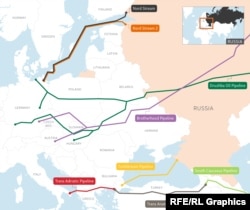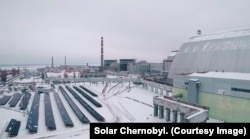Chernobyl is again churning out energy -- not nuclear, but solar power.
In the shadows of the shuttered nuclear power plant that was the scene to the world's worst nuclear disaster more than 30 years ago, rows of solar panels have been erected, producing enough energy to light up hundreds of homes.
It's all part of a bold plan by Ukraine to develop alternative sources of energy.
Upon gaining independence, post-Soviet Ukraine relied on Russia to meet most of its energy needs. But the strategy came with risks, such as in 2006 and 2009, when disputes led Russia to temporarily halt its gas transit via Ukraine and threaten European imports.
The dependence on Russian natural gas and oil was further exposed as a liability after Russia seized Crimea in March 2014 and began supporting separatists in eastern Ukraine a month later.
And the need for Kyiv to tap into alternative energy sources has become ever more apparent as Nord Stream 2, a pipeline that will circumvent Ukraine in delivering Russian gas to Europe via the Baltic Sea, prepares to go online, possibly as early as next year.
The development threatens to elbow Ukraine out of the gas-transit business, further eroding whatever leverage Kyiv may have with Moscow on energy matters.
Ukraine has scrambled to secure gas and oil from other sources, even from as far away as the United States. It still relies heavily on nuclear -- globally, only France embraces the atom as an energy resource more than Ukraine. But given its power predicament, Ukraine is eager to pursue other sources. Now wind, solar, hydro, and biomass are not only getting attention, but investment.
Read More Of Our Special Coverage
Comic Or Commander In Chief? Reform Of Ukrainian Defense Industry Giant Tests Zelenskiy's Will
Mission: Impossible? Ukraine's New President Ventures To Reform Powerful State Spy Agency
After Years Of Stalling, Can Ukraine Finally Become Energy Self-Sufficient?
Greener Pastures For Ukrainian Farmers? Zelenskiy Plows Ahead With Land Reform
Ukraine expects to more than double its renewable capacity in 2019, a government commission announced in September. Companies from the United States, Germany, Norway, Finland, France, and Canada are just some of those involved in renewable-energy projects, attracted by a green tariff that guarantees producers a fixed price.
According to the International Energy Agency (IEA), renewable-energy sources, especially wind and solar, "have grown significantly over the last decade," in the Eastern European country of nearly 45 million. A Ukrainian official told RFE/RL that more than 100 green-energy projects had been completed and more than 100 were in the planning stage.
However, despite the flurry of financing and accompanying hype, renewable energy is still a far cry from the 25 percent that Ukraine has set as a target for renewable-energy production by 2035. The country's renewable-energy efforts have failed to impress some experts, with a respected global energy index scoring Ukraine low on that account. Moreover, President Volodymyr Zelenskiy has talked about reining in the green tariff, technically called a feed-in tariff (FIT), that is one of the highest in the world and which is widely acknowledged as crucial in spurring growth.
Chernobyl's 'Terra Incognita' Comes To Life
The solar power plant at Chernobyl, the site of the infamous 1986 nuclear disaster, first began delivering electricity to Ukraine's energy grid on July 1, 2018. Covering over 1.6 hectares, its 3,800 panels produce enough energy to power about 2,000 apartments.
Costing just some 1 million euros ($1.2 million), the 1-megawatt (MW) solar plant is a joint project of Ukrainian company Rodina and Germany's Enerparc AG.
"The Chernobyl accident was the largest man-made disaster in human history. For 33 years, the Chernobyl zone has been 'terra incognita' of Ukraine from an environmental, social, and economic point of view. We had the opportunity to give contaminated territories a second chance," says Yevhin Variahin, CEO and founder of Rodina, the consortium overseeing the Solar Chernobyl project.
Variahin adds that there are plans to expand the site. "The consortium's strategy is to scale up the Solar Chernobyl project to 100 MW. This year, Rodina won a tender for the construction of the next 7 MW at Chernobyl," he says.
One Of Many Projects
U.S.-based General Electric (GE) and Ukraine's LongWing Energy S.C.A. in July announced a $150 million package to finance the first phase of the Zaporizhzhya Wind Farm, in the Zaporizhzhya region in southeast Ukraine. The 98 MW plant is expected to go online in 2020.
The U.S. Overseas Private Investment Corporation (OPIC) provided financing for what will be GE's fourth wind-power project in Ukraine.
"OPIC is proud to support this project, which will advance energy independence and security in Ukraine," OPIC acting President and CEO David Bohigian said on July 25. "The plant will help Ukraine meet its energy demands and reduce reliance on imported sources, powering homes and businesses across the country."
Danish-based Vestas, German-based NOTUS Energy, and Irish-based Altostrata are just some of the other companies to announce wind-power projects in Ukraine in 2018-19. Ukraine's DTEK, the country's largest private energy company, is a key player in the country's renewable-energy sector, accounting for nearly half of all such investments in 2018.
Robust Renewable Energy
The current year -- 2019 -- has been good to renewable energy in Ukraine. The combined capacity of new renewable-energy facilities launched during the third quarter of 2019 alone was 956 MW, which represents a six-fold increase year on year, according to figures released in late September by Ukraine's National Commission for Energy, Housing, and Utilities Services Regulation (NCER). Over that period solar-power capacity grew more than five times to reach 780 MW. Based on the updated data, renewable energy currently accounts for 4.9 percent of Ukraine's overall energy production.
The International Energy Agency (IEA) has taken note of the country's progress. "Outside of hydro, wind and solar have grown significantly over the last decade," Merve Erdil, an IEA spokeswoman, said in written comments to RFE/RL.
Globally, the IEA is forecasting double-digit renewable power growth in 2019, driven by solar. It put this down to cost. The cost of solar has plunged more than 80 percent since 2010.
Since 2015, Ukraine has installed nearly 4,000 MW of renewable-energy capacities, attracting some 3.3 billion euros ($3.7 billion) of investment, according to Kostyantyn Gura, an adviser to the head of the Ukrainian State Agency of Energy Efficiency. A government-linked website maps 103 completed and 112 prospective renewable-energy projects, Gura notes.
Renewables have their backers in Zelenskiy's new cabinet, foremost among them being Oleksiy Orzhel, the new minister of energy and environmental protection who formerly served as the head of the Ukrainian Association of Renewable Energy.
Viable Goals?
By 2035, Ukraine wants renewable energy to account for 25 percent of the country's energy pie, according to the Energy Strategy of Ukraine for 2035.
While optimistic, Gura notes that Ukraine will need to clear many hurdles to reach the ambitious target. "Reaching this goal requires attracting $30 billion of investments, implementing efficient financial tools, favorable legal basis, and fruitful cooperation of all government authorities and market participants," he told RFE/RL in written comments.
While great strides have been made, Ukraine is still reliant on "old energy," including coal. Ukraine imported 21 million metric tons of coal in 2018, putting it at No. 10 on the IEA's list of top coal importers. Nuclear is also dominant in Ukraine. In 2018, Ukraine got 55.4 of its electricity from the atom, according to IEA data. Only France, which relies on nuclear power for 71.5 percent of its total domestic electricity generation, is higher.
Ukraine scored impressively on a respected index ranking 56 countries largely on their efforts to fight global warming. It's placement of 18 in the Climate Change Performance Index 2019 put Ukraine in the "high-performing countries" category, but the authors of the report noted that "is more a result of the economic crisis, due to the ongoing conflict in the Donbas region, than of effective climate policy."
On its renewable-energy efforts alone, Ukraine placed a lowly 43, better than Russia at 60 and Belarus at 52, but worse than Poland at 40 and Kazakhstan at 39.
Much of Ukraine's continued renewable-energy progress could hinge on the fate of the green tariff. Approved in 2009 during the presidency of Viktor Yushchenko, the FIT's set prices eased producers' concerns about market fluctuations.
"The feed-in tariff for green projects in Ukraine is one of the highest in the world, which makes investment into this sector very attractive," according to a 2018 report by the consultancy firm Baker McKenzie.
However, during his media marathon with 300 journalists at a posh Kyiv food court on October 10, Zelenskiy suggested that while the green tariffs were good, they were a strain on state coffers, and may need to be lowered to allow "market forces to work."
"Zelenskiy's reference to the FIT during his marathon has already raised concerns in the environmental movement," says Ilya Yeremenko, an activist with the energy-oriented environmental NGO Ekoklub, who also notes that as of 2020 Ukraine will determine energy rates on renewable projects via "auctions."
Yeremenko is cautious about Ukraine's renewable future, saying a long road still lays ahead. "Advances on renewables have not and will not relieve the country's energy dependence drastically. It will take years and years before renewable-energy supplies will be a significant share in our energy balance," Yeremenko explains.
"The conflict with Russia spurred energy-efficiency efforts, leading to less gas used, and also new contracts signed with European gas suppliers, which still pump Russian gas but not under Russian rules anymore. The urgent need for energy independence is just an additional argument for renewables."





